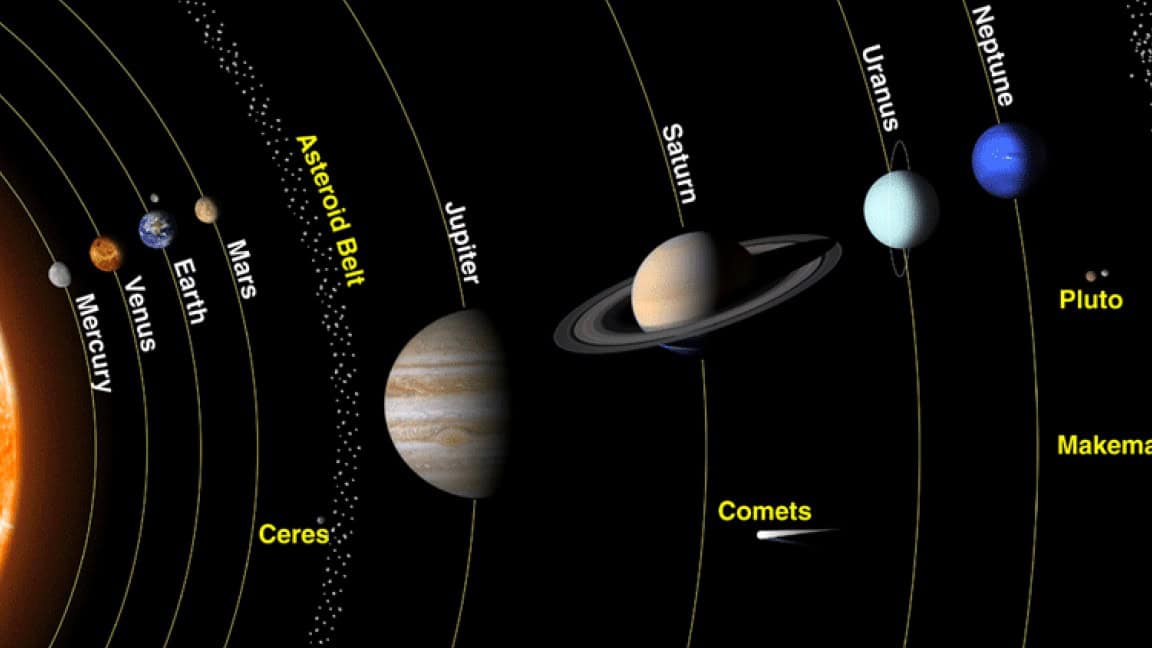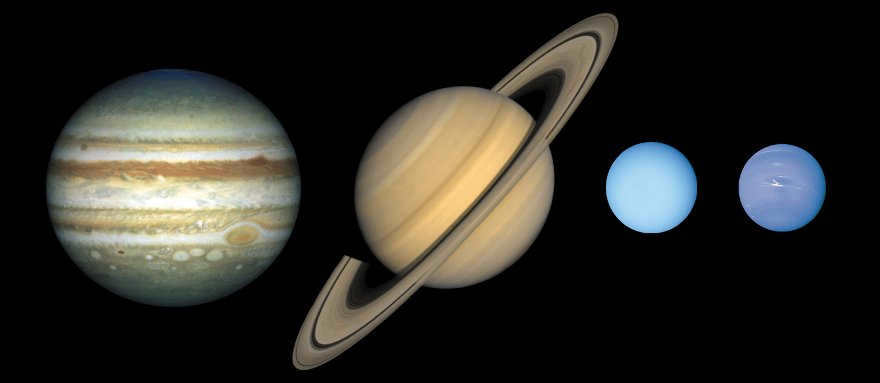
In our solar system, there are two categories of planets: inner planets and outer planets. The inner planets, which are closer to the star, are known as terrestrial planets. These planets are composed of silicate minerals and metal. On the other hand, beyond the asteroid belt, we find the gas giants, which are the outer planets of our system.

There are a total of four gas giants, each with their own unique characteristics. Through the deployment of probes, we have been able to gain a deeper understanding of these celestial bodies and uncover a wealth of fascinating knowledge.
Understanding the concept of gas giants
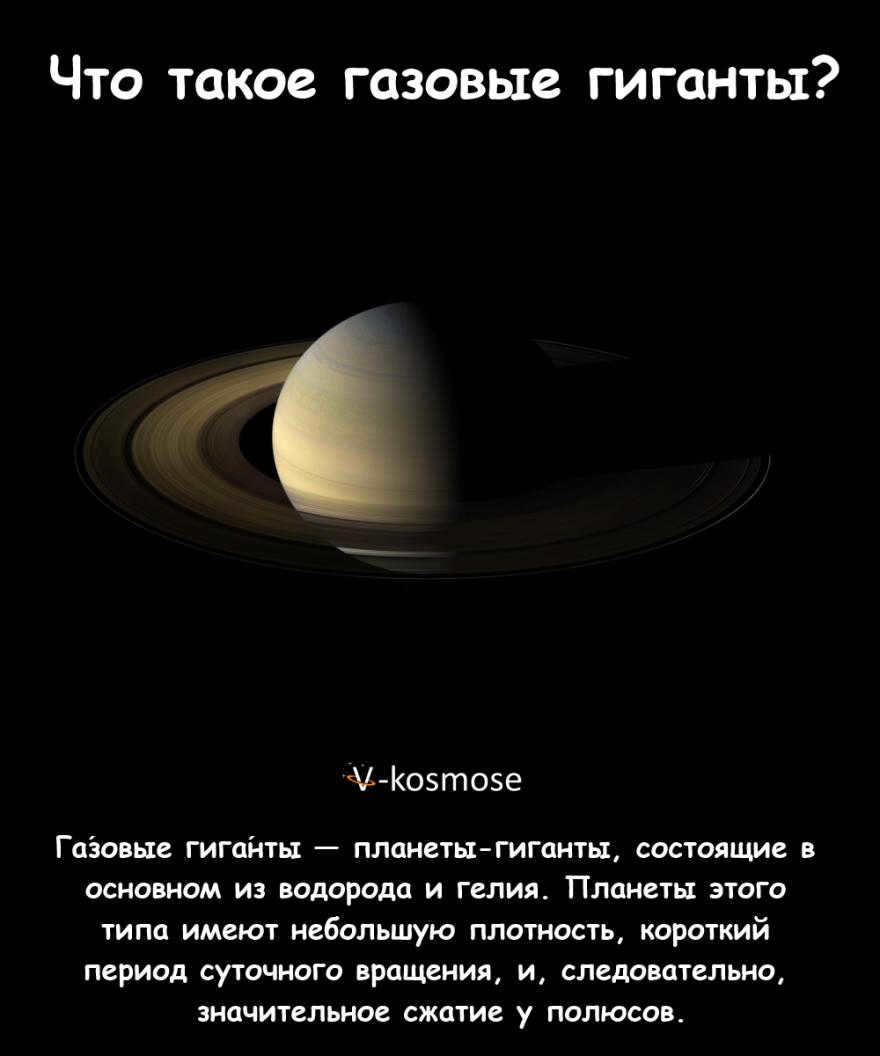
A gas giant is a celestial body composed mainly of hydrogen and helium. The term “gas giant” was coined by James Blish in 1952. Blish, a science fiction author, used the term to describe these planets, although in reality, the elements in gas giants undergo a transformation into liquid or solid forms at certain depths.
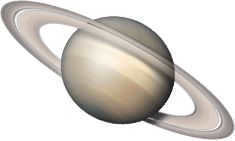
Gas giants have a lower concentration of metallic elements and silicates in their central regions. However, this terminology has become widely accepted and is now the officially recognized term. In a similar vein, the designation “ice giants” was assigned to Uranus and Neptune, which contain significant amounts of volatile substances.
Categorization of gas giants
There are five classifications based on the scheme developed by David Sudarka.
- Category I – characterized by the presence of ammonia clouds. This group includes planets located in the outer regions of their respective systems, beyond the ice line. The ice line represents the distance at which volatile substances condense into solid ice particles.
- Category II – characterized by the presence of water clouds. These planets have average temperatures of -23°C, which is too warm for the formation of ammonia cloud cover. Water clouds are more reflective, resulting in a higher albedo.
- III – cloudless. The temperature will rise to 80°C-530°C, resulting in a lack of cloud cover due to insufficient chemicals. These objects have a low albedo and will appear as hazy blue orbs because methane absorbs red wavelengths.
- IV – Alkali Metals. When heated above 627°C, carbon monoxide begins to dominate the atmosphere. The quantity of alkali metals also increases. These objects are known as hot Jupiters.
- V – silicate clouds. These are the hottest giants, with temperatures exceeding 1100°C. Silicate and iron cloud formations are found in the upper atmospheric layer. They will appear red when observed through telescopes.
A knowledgeable tarot reader will provide answers to the following questions:
What does the future hold for you? How will your relationships develop? What is the right decision to make?

Important details about gas giants
Jupiter is the largest among the gas giants in our solar system. Its size is nearly 11 times bigger than Earth’s. It has a total of 79 moons. The planet is primarily made up of ice and rock. The majority of its mass is composed of liquid metallic hydrogen, which generates a massive magnetic field. Due to its immense size, Jupiter can be seen in the night sky without the aid of telescopes. The atmosphere consists of ammonia, hydrogen, helium, and methane.
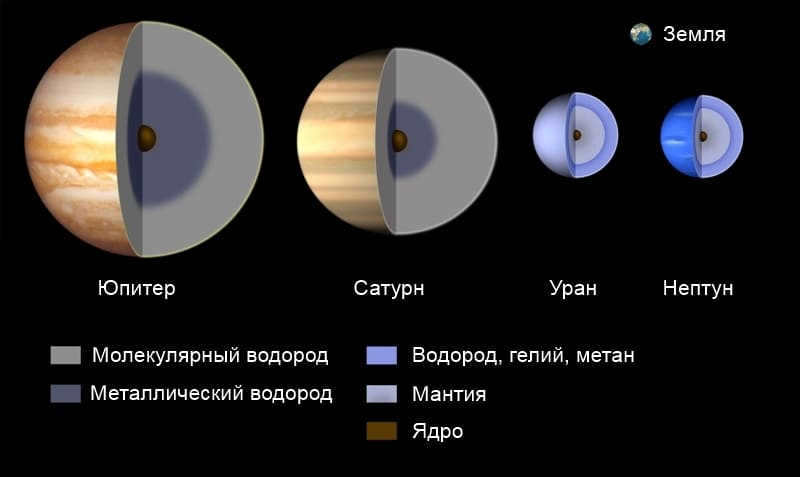
The composition and characteristics of gas giants
Saturn’s size is 9 times that of Earth’s radius and is known for its mesmerizing ring system. It is host to 62 moons and is predominantly composed of hydrogen and helium, with a dense core at its center. Its atmosphere is similar to that of Jupiter.
Uranus, on the other hand, is four times the size of Earth. It stands out due to its unique tilt angle, which gives it an almost sideways appearance. It also has a retrograde rotation. The planet has a family of 27 moons and its atmosphere consists of hydrogen, methane, and helium. Uranus was first discovered by William Herschel in 1781.

Gas giants in the solar system have a significant axial tilt.
Furthermore, Neptune, which is four times larger in radius than Earth, shares a similar atmospheric composition with Uranus. In addition, it is accompanied by 14 satellites in orbit. This planet was first observed in 1846.
From the beginning, it is thought that giants emerged as rocky and icy planets similar to Earth. However, their cores were much larger, allowing them to attract more hydrogen and helium from the gas cloud before the star formed.
Uranus and Neptune, being farther away, faced more difficulty in accumulating material. As a result, they are smaller than the initial giants. Additionally, their atmospheres are more polluted with heavy elements such as methane and ammonia.
Scientists have discovered thousands of exoplanets, including a significant number of hot Jupiters. These gas giants are located extremely close to their stars. It is believed that they originally formed farther away but migrated closer over time.
Large-scale lunar families are formed by giants. Many of them are found alongside planets, while others are drawn in by gravity. They typically orbit in the same direction as the planets, but Triton, located at Neptune, moves in the opposite direction. This suggests that it is a captured object.
Current studies on gas giants
Each planet possesses a complex atmospheric layer and a series of massive storms. For instance, the Great Red Spot on Jupiter has been raging for four centuries and is currently diminishing in size. Extensive research is required to determine the precise nature of these weather formations.
A skilled tarot reader will address the following inquiries:
What lies ahead in your future? How will your relationships evolve? What is the correct course of action?

Currently, the Cassini mission has completed its mission on Saturn, while Juno is currently studying Jupiter. Scientists are also planning to investigate seismic waves that resemble features similar to earthquakes found on Earth.
Exoplanets and gas giants
The exploration of extraterrestrial worlds has revealed a vast number of gas giants that are significantly larger than Jupiter. Some of these giants are even close to reaching star status. However, due to their extremely distant location from us, it is challenging to determine their exact albedo and spectra.
The majority of these gas giants are classified as super-Jupiters, as they are easier to detect. These objects can be further divided into cold and hot Jupiters. The former are rich in hydrogen and have a mass that is 1.6 times greater than Jupiter.
Hot Jupiters possess a vast quantity of hydrogen. When gas giants expand to be 13-80 times the size of Jupiter, they transform into brown dwarfs. These entities are bigger than any planet, yet they lack the necessary mass to initiate nuclear fusion in their cores and thus cannot evolve into fully-fledged stars.
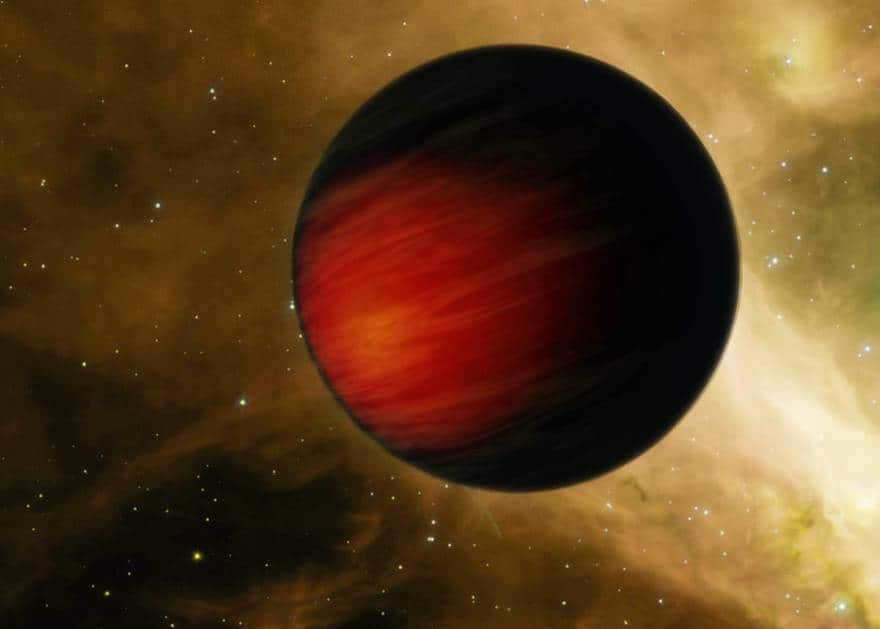
The solar system houses only four gas giants, making them a fascinating subject for study due to their diversity and complexity. These planets not only provide valuable insights into the formation of our own system but also present a unique puzzle to solve.
There have been numerous discoveries of super-Earths, which are exoplanets that fall between the size of Earth and Neptune. This diversity is not observed within our own solar system, leaving scientists uncertain whether these planets resemble giant planets or are more similar to Earth.
The scientific community is eagerly anticipating the launch of the James Webb Telescope, as it is expected to enhance the search capabilities and provide a deeper understanding of the cosmos.
- Gas giants are celestial bodies primarily consisting of hydrogen, helium, ammonia, methane, and various other gases. These planets possess a low density, a relatively quick rotational period, and as a result, experience considerable compression at their poles. Additionally, their surfaces effectively reflect, or scatter, the sun’s rays.
In our solar system, there are several massive gas giants, including Jupiter, Saturn, Uranus, and Neptune. According to the theory of solar system formation, these giant planets formed later than the inner planets, such as Earth and Mars. By that time, most of the solid materials like oxides, silicates, and metals had already condensed out of the gaseous phase, leaving behind only the gaseous envelope. The inner planets then formed from these solid materials. There is also a hypothesis that suggests the existence of a fifth gas giant, which was either pushed out to the outskirts of the solar system (thus becoming a hypothetical planet like Tyuhe or “Planet X”) or beyond its boundaries (becoming an orphan planet). The most recent hypothesis of this kind is the ninth planet hypothesis proposed by Brown and Batygin.
Out of all the known gas giants, the largest one is an exoplanet called TrES-4b.
Gas giants are known for their incredibly fast rotation, with periods ranging from 9 to 17 hours.
According to data collected by the Galileo lander, the gas planets experience a rapid increase in pressure and temperature in their upper layers. For example, at a depth of 130 kilometers in Jupiter’s atmosphere, the temperature reached approximately 420 kelvins (145 degrees Celsius) and the pressure was 24 atmospheres. It is worth noting that all gas planets in the Solar System emit significantly more heat than they receive from the Sun. This can be attributed to the release of gravitational energy during the compression process. While there have been models suggesting that Jupiter may release a small amount of heat through fusion reactions, these models have not been confirmed through direct observation.
In the atmospheres of gas giants, powerful winds blow at speeds of several thousand kilometers per hour (the equatorial wind speed on Saturn is 1800 km/h). These planets also feature permanent atmospheric formations in the form of massive vortices. One notable example is the Great Red Spot on Jupiter, which has been observed for over 300 years and is several times the size of Earth. Other gas giants like Neptune have their own giant vortices such as the Great Dark Spot, as well as smaller spots on Saturn.
All gas planets in our solar system have a satellite-to-planet mass ratio of about 0.01% (1 in 10,000). This fact is explained by models of satellite formation from gas-dust disks that contain a significant amount of gas. These models also incorporate mechanisms that limit the growth of satellites.
Gas planets can only form if they are large enough, as smaller celestial bodies lack the gravitational pull necessary to retain light gases like hydrogen.
Linked ideas
The immense planets are four planetary bodies situated beyond the asteroid belt in our solar system (Jupiter, Saturn, Uranus, and Neptune). These outer planets, which share various physical properties, are also referred to as giant planets.
Mini-Neptune (or Gas Carroll) is a category of planets that fall between gas giants like Uranus and Neptune and Earth-like planets.
A protoplanetary disk or proplid is a spinning circumstellar disk consisting of dense gas that surrounds a young, newly formed star, protostar, Taurus, or Herbig (Ae/Be) star, and eventually gives rise to planets. Also known as an accretion disk, a protoplanetary disk is formed when the gaseous material that composes it falls from the inner radius onto the star’s surface.
Earth’s mass (M⊕) is the measurement of the mass of our planet, and is commonly used as a unit of mass in astronomy. 1 M⊕ is equivalent to (5.9722 ± 0.0006) × 1024 kg.
The terrestrial planets, including Mercury, Venus, Earth, and Mars, are the four planets that exist within the inner region of our Solar System. These planets differ from the giant planets, which are located in the outer region. In many extrasolar planetary systems, exoplanets are also categorized into solid planets found in the inner regions and gas planets found in the outer regions, according to various cosmogonic theories. Some rocky asteroids exhibit similar structure and composition to the Earth-group planets.
References in written works
Jupiter is the largest celestial body in our solar system. It is officially categorized as a gas giant and boasts a remarkable collection of 67 satellites, with its most renowned ones being Europa, Io, Ganymede, and Callisto. The composition of Jupiter primarily consists of hydrogen (approximately 82 percent), accompanied by traces of helium, methane, and ammonium. Although water exists on Jupiter, it is present in minuscule amounts, accounting for less than one percent of the planet’s overall composition. In terms of size, Jupiter is a staggering 11 times larger than Earth, and it completes a full orbit around the Sun in 12 Earth years.
The primary question that persists in the entire “asteroid problem” is whether astronomers can accurately and timely predict the emergence of the space meteorite threat based on contemporary observations. Meanwhile, the electronic simulation of the movement of cometary nuclei, which periodically emerge from the distant vicinity of the Solar System, indicates that their paths are considerably unpredictable. Frequently, comets that wander between gas giants ultimately disintegrate due to the intense gravitational forces and collide with Jupiter.
Continuation of Related Concepts
Astronomers have given various names to orphan planets, including vagrant planets, planemos, strange planets, interstellar planets, free-floating planets, free-flying planets, quasi-planets, or solitary planets. These objects have a mass similar to that of a planet and a spherical shape, making them essentially planets. However, unlike traditional planets, orphan planets are not gravitationally bound to any star, brown dwarf, or even another planet (although they may have satellites). Even if an orphan planet is located within a galaxy, it remains unattached.
A super-Earth (also known as a super-Earth) is a type of planet with a mass greater than that of Earth but much less than that of gas giants. The term “super-Earth” refers specifically to the planet’s mass and does not depend on its proximity to its star or any other criteria.
An ice giant is a distinct class of planets/exoplanets that are primarily composed of substances such as water, ammonia, methane, hydrogen sulfide, and rock (which make up about a quarter of the planet’s mass). These substances exist in a solid state in outer space and are commonly referred to as ice (excluding the rocks, of course). While these substances are in a mantle state of high pressure and temperature on the planet, resulting in a supercritical fluid state, the planets are still referred to as icy. Topic.
The habitable zone, also known as the HZ, is an area in space that is defined based on the assumption that planets within it will have conditions similar to Earth and can support liquid water. It is believed that these planets, or their moons, would be favorable for the development of life similar to what we have on Earth. The best chance for life to originate is within the habitable zone around a star, also known as the circumstellar habitable zone.
An Earth analog, or Twin Earth, refers to a hypothetical exoplanet that is similar to Earth in terms of size, mass, and temperature, and is located within the habitable zone of a star.
The solar system is a planetary system that consists of the central star, known as the Sun, and all the celestial objects that orbit around it. It came into existence around 4.57 billion years ago as a result of the gravitational compression of a cloud of gas and dust.
An astronomical unit, also known as AU, is a unit of distance measurement in astronomy. It has been traditionally used and was previously referred to as ua. The initial definition of an AU was based on the major semi-axis of Earth’s orbit, which is considered to be the average distance between the Earth and the Sun: 126.
Subdwarfs, previously known as sd stars (e.g., sdM5e), are classified as luminosity class VI according to the Yerkes classification. These stars have a brightness that is 1.5-2 magnitudes dimmer than main-sequence stars of the same spectral class. In the Hertzsprung-Russell diagram, subdwarfs are located below the main sequence.
Herbig stars, also known as Ae/Be stars, are young stars (up to 10 million years old) with spectral class A or B that have not yet reached the main sequence. They have a mass 2 to 8 times greater than the mass of the Sun. They are found in areas where stars are forming, surrounded by clouds of gas and dust, and have surface temperatures ranging from 3500 to 6000 K. The spectra of these stars are characterized by strong emission lines, predominantly from the Balmer series of hydrogen and ionized calcium in the optical range. These stars belong to a unique system.
A planetary system is a collection of stars and various celestial objects that are not stars. These objects include planets and their moons, dwarf planets and their moons, asteroids, meteoroids, comets, and cosmic dust. They all orbit around a common center of mass. When several stars are gravitationally bound and have closed orbits, they form a stellar system. The solar system, which includes the Earth, is a planetary system that revolves around the Sun.
A circumstellar disk is a cluster of matter that has a torus- or ring-like shape. It consists of gas, dust, planetesimals, or asteroids that orbit around a star.
Mini-Earth is a planet that is significantly smaller in mass compared to Earth and Venus. In the Solar System, this category of planets includes Mars and Mercury. Due to their low mass, planets of this kind are extremely challenging to detect using the radial velocity method. As a result, the transit method is presently considered the most efficient means of detection. Despite the obstacles, one of the earliest mini-Earths found beyond our solar system was located near the millisecond pulsar PSR 1257+12. The tiniest of these mini-Earths is WD 1145+017 b, with a radius measuring just 0.15.
< p >A Protoplanet is a planetary embryo that exists within a protoplanetary disk. During its development, it undergoes an internal melting stage, causing differentiation of its interior. These celestial bodies are believed to have formed through the gravitational attraction and collision of kilometer-sized planetesimals. According to the theory of planet formation, the protoplanets perturb each other’s orbits and collide, gradually growing into larger planets.< /p >
< p >Planetary rings are flat concentric formations of dust and ice that orbit a planet in its equatorial plane. Rings can be found around gas giants in the Solar System, including Saturn, Jupiter, Uranus, and Neptune. Additionally, rings have been observed around the asteroids Chariklo and Chiron, the dwarf planet Haumea, and there is a hypothesis that Saturn’s satellite Rhea may also have rings.< /p >
There are three categories of stars that share similarities with the Sun: solar-type stars, solar analog stars, and solar doubles. Studying these stars is crucial for gaining a better understanding of the Sun’s properties and determining whether it is unique or typical among other stars. Additionally, this research can shed light on the potential existence of habitable planets in other solar-type stars.
The Oort Cloud is a theoretical spherical region within the Solar System that is believed to be the source of long-period comets. While the existence of the Oort Cloud has not been directly confirmed, there is substantial evidence supporting its presence.
The galactic halo, also known as the stellar halo, is an imperceptible component of the galaxy that forms the primary part of its spherical subsystem. This halo takes on a spherical shape and stretches beyond the observable region of the galaxy. It is primarily composed of rarefied hot gas, stars, and dark matter, which account for the majority of the galaxy’s mass.
A planetesimal, derived from the English words “planet” and “infinitesimal,” refers to a celestial body that orbits a protostar. It forms through the gradual accumulation of smaller bodies made up of dust particles from the protoplanetary disk. By continuously attracting new material and accumulating mass, planetesimals grow into larger bodies. The individual fragments that constitute a planetesimal, mutually attracting one another, begin to compact. An example of a planetesimal is the asteroid Lutetia.
A transit, also known as an astronomical transit, refers to an astronomical event where one celestial body moves in front of another celestial body, blocking a portion of its view when observed from a specific vantage point.
An oceanic planet, on the other hand, is a unique type of planet primarily composed of ice, rock, and metals. The composition of these elements is roughly equal in mass proportion, simplifying the planetary model. Depending on the planet’s distance from its parent star, it is possible for the entire surface to be covered by a liquid water ocean, reaching depths of up to 100 km. The depth varies depending on the planet’s radius, and at greater depths, the pressure becomes so intense that the water transitions from a liquid state to a solid state, resulting in different forms of ice, such as Ice V.
The Orion Cloud is a group of interstellar matter (nebula) located in the Orion constellation. Situated in the Milky Way galaxy, the Orion Cloud is approximately 1600 light years away from the Sun and has dimensions spanning a few hundred light years.
The Goldfish constellation (known as Dorado in Latin) can be found in the southern hemisphere of the sky. It covers an area of 179.2 square degrees and contains 32 stars that are visible to the naked eye.
The planetary equilibrium temperature refers to the hypothetical temperature that a planet would have if it were a completely black body solely heated by the star it orbits. This model does not take into account the presence or absence of an atmosphere (including the greenhouse effect) and assumes that the planet’s surface radiates at the theoretical blackbody temperature.
Astronomy uses the term “diffuse (light) nebula” to refer to nebulae that emit light. There are three types of diffuse nebulae: reflective nebula, emission nebula, and supernova remnants. Diffuse nebulae are different from non-diffuse dark nebulae, which are nebulae with highly dispersed molecules.
The infrared excess is a measured parameter of an astronomical source. It indicates that the source has a higher measured infrared flux than expected, assuming that the star radiates as a completely black body. On the left, you can see the spectral energy distribution of the white dwarf G29-38. The detected emission at wavelengths longer than 2 microns is stronger than expected from the extrapolated visible spectrum of the white dwarf, indicating an excess of infrared.
Close binary systems are a type of binary systems in which, during certain stages of their evolution, the constituent components have the ability to transfer mass between them. The separation between the stars in a close binary system is comparable to the size of the stars themselves. As a result, these systems exhibit more complex effects beyond simple gravitational attraction, such as tidal distortion of shape and heating from the brighter companion. The exchange of matter has a significant impact on the stellar evolution, thus shaping the characteristics of the components in close binaries.
Microquasars, also known as X-ray double stars, are binary stellar systems where the remnants of the first star, which have been compressed into dark compact objects such as neutron stars or black holes, are gravitationally bound to the second normal star. The second star orbits closely around the first component.
The snow line refers to a specific distance from a star in a protoplanetary system where the temperature drops low enough for certain compounds to solidify. These compounds can include water, ammonia, methane, as well as molecular nitrogen and chlorine.
A SuperNova Remnant (SNR) is a formation of gas and dust that occurs after a star undergoes a catastrophic explosion, turning into a supernova. The explosion causes the supernova shell to expand in all directions, creating a shock wave that moves at an incredibly high speed. This shock wave interacts with interstellar matter, forming the supernova remnant. The remnant is composed of material ejected by the explosion and interstellar matter that has been affected by the shock wave.
Nemesis is a theoretical star that is difficult to detect (red dwarf, white dwarf, or brown dwarf). It is believed to revolve around the Sun at a distance of 50-100 thousand astronomical units (0.8-1.5 light-years), beyond the Oort cloud.
Retrograde motion refers to motion that goes against the direction of forward motion. This term can apply to the rotation of one celestial body around another in orbit, or to the rotation of a body around its own axis, as well as to other orbital parameters such as precession and nutation. In the context of planetary systems, retrograde motion typically refers to motion that is opposite to the rotation of the central body, which is the primary object in the system.
A comet’s coma, derived from the Latin word “coma” meaning hair, refers to the cloud of dust and gas that surrounds the comet’s nucleus. These two components, the coma and the nucleus, together form the head of the comet. As the comet approaches the Sun, the size of the head increases and occasionally a tail becomes visible.
A nebula, on the other hand, is a distinct section of the interstellar medium that stands out due to its radiation or absorption of radiation against the backdrop of the sky. In the past, any stationary extended object in the sky was referred to as a nebula. However, in the 1920s, it became evident that many of these nebulae were actually galaxies, such as the Andromeda Nebula. Since then, the term “nebula” has been used in a more specific sense. Nebulae are composed of a combination of dust, gas, and plasma.
A star cluster is a group of stars that share a common origin and move together in the galaxy’s gravitational field. Some star clusters also contain clouds of gas and/or dust.
Dwarf elliptical galaxies, denoted dE, are a type of elliptical galaxy that have low luminosity and size. They are often found in galaxy clusters or act as companions to normal galaxies.
Symbiotic stars are a unique type of double star with complex spectra that include emission lines and TiO absorption bands. Their spectra also show characteristic lines from nebulae (OIII, NeIII, etc.), singly ionized metals, and forbidden lines of high ionization (e.g., FeVIII). All known symbiotic stars are variable, with periods lasting several hundred days.
A celestial body that orbits a star or its remnants and is large enough to be shaped by its own gravity, but not large enough to undergo a thermonuclear reaction, is known as a planet. The term “planet” is derived from the Greek word “πλανήτης,” which is an alternative form of the word “πλάνης” meaning “wanderer.” Additionally, a planet must have cleared the area around its orbit of smaller objects called planetesimals.
Cosmic dust, also known as micrometeorites, refers to dust particles that are found in space. These particles can range in size from a few molecules to 0.2 microns. It is estimated that approximately 60 tons of space dust are deposited on planet Earth every day. Other studies suggest that around 40 thousand tons of space material accumulate in a year.
Synchronous rotation, also known as tidal capture, refers to the phenomenon when a satellite’s rotation period around its axis matches its period of revolution around a central body. This results in the satellite always presenting the same side towards the central body, as it completes one rotation around its axis in the same amount of time it takes to orbit around the central body. Tidal entrapment occurs during mutual motion and is a common characteristic of many large natural satellites in the solar system.
The gas giants in the solar system, like any other, are predominantly composed of gases. The physical and chemical properties of these planets are so distinct from our environment that they naturally pique the interest of individuals, even those who are not particularly interested in astronomy.
Gas giants
Gas giants are a type of planet that are primarily composed of hydrogen and helium gases. They are also known as “failed stars” because they do not have enough mass to sustain nuclear fusion in their cores like stars do. Gas giants are typically much larger than terrestrial planets, with sizes ranging from about 10 to 100 times the mass of Earth. They have thick atmospheres and lack a solid surface, making them inhospitable to life as we know it. Despite their different composition and lack of solid surface, gas giants can still have a complex system of moons and rings. Some famous examples of gas giants in our solar system include Jupiter and Saturn.

It is common knowledge that the objects within our star system can be classified into two main categories: terrestrial and gas. The latter category consists of planets that lack a solid outer shell. Within our star system, there are four such gas giants:
The gas giants within our star system possess a certain level of uncertainty when it comes to differentiating between their core, shell, and atmosphere. In fact, scientists are still unsure about the existence of a solid core within these planets.
Based on the most widely accepted theory regarding the formation of our solar system, the gas giants came into existence much later than the terrestrial planets. As one delves deeper into the atmosphere of these gas giants, the pressure increases. It is believed by experts that the pressure near the center of these planets is so immense that hydrogen transitions into a liquid state.
Gas entities spin quicker on their axis compared to solids. Interestingly, the celestial bodies (gas giants) within the solar system emit more warmth than they absorb from the Sun. This phenomenon can be partly accounted for by gravitational energy, but the source of the remaining portion remains somewhat elusive to scientists.
Planet Jupiter
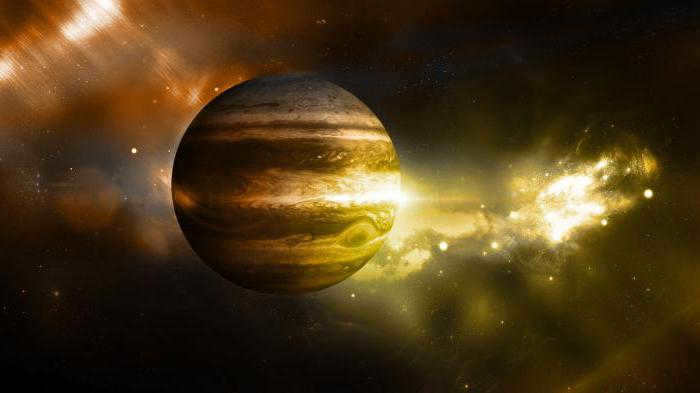
Jupiter, the gas giant, holds the title of being the largest planet in our solar system. Its immense size allows it to be visible to the naked eye. When gazing at the night sky, one can easily spot Jupiter as the third brightest object, only surpassed by the Moon and Venus. Even through a small telescope, it is possible to observe the distinct disk of Jupiter along with its four accompanying satellites.
Jupiter, being the nearest gas giant to us, holds the position of being the most extensively researched among the planets in its category. It is this celestial body that has attracted the most spacecraft missions. Currently, the Juno probe is stationed in orbit, gathering valuable data about Jupiter and its moons. The spacecraft was launched back in 2011 and by July 2016, it successfully reached Jupiter’s orbit. In August of the same year, it achieved the closest proximity ever recorded, circling just 4,200 kilometers above the planet’s surface. The next major milestone for Juno is set for February 2018, when it is scheduled to descend into Jupiter’s atmosphere. The anticipation for the images of this historic event is palpable worldwide.
The planet Saturn
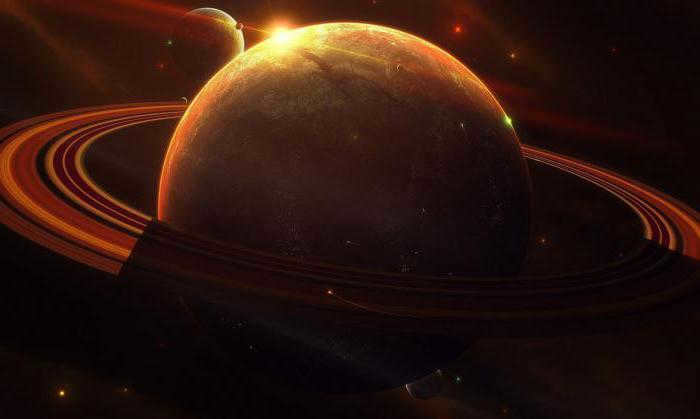
Saturn, the second largest gas giant in our solar system, is renowned for its enigmatic nature, primarily due to its majestic rings, the origin of which remains a subject of debate among scientists worldwide. Modern research indicates that these rings are composed of a diverse array of materials, including rocks, ice, and dust particles of various sizes. Within this celestial spectacle, one can find tiny specks of dust as well as objects reaching up to a kilometer in diameter. Interestingly, the width of Saturn’s rings is so immense that it could span the distance between Earth and the Moon, while their actual width is only about a kilometer.
Notably, the amount of light reflected by Saturn’s rings surpasses that of the planet itself. Even with a relatively modest telescope, one can observe the mesmerizing beauty of Saturn’s rings.
The giant possesses extremely powerful winds – cyclones with an average velocity of 1800 km/h are observed at the equator. To get a rough idea of their strength, they can be compared to the most intense tornadoes, which reach speeds of up to 512 km/h. Saturn’s day passes swiftly – a mere 10 hours and 14 minutes, while its year stretches for 29 Earth years.
Uranus
can be rephrased as
The planet Uranus
.
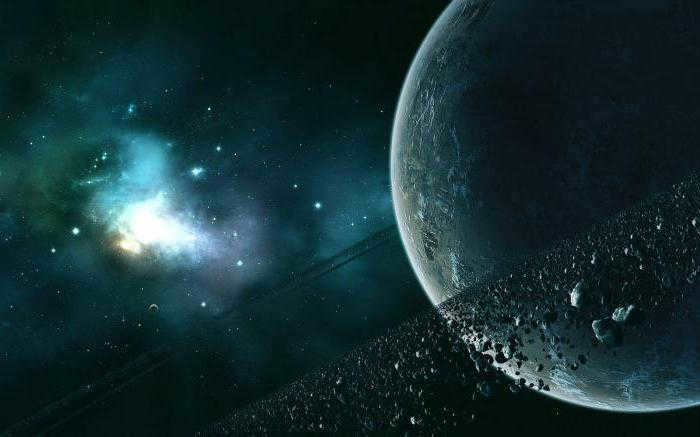

Uranus is classified as an ice giant due to its composition of both rocks and high-temperature variations of ice beneath its hydrogen, helium, and methane atmosphere. Researchers have observed clouds composed of hydrogen, ammonia, and ice drifting within Uranus’ atmosphere.
With temperatures reaching as low as minus 224 degrees, Uranus possesses the coldest atmosphere within our Solar System. Scientists theorize that the presence of water on this massive planet increases the potential for life to exist.
One fascinating aspect of Uranus is its unique orientation in space: its equator is positioned perpendicular to its orbit, giving the planet a sideways appearance. This unusual tilt results in a one-of-a-kind change of seasons. The planet’s poles experience periods of complete darkness lasting 42 Earth years. By simple calculation, Uranus completes a full orbit around the Sun in 84 Earth years. Its rotation on its axis takes 17 hours and 14 minutes, although powerful winds reaching speeds of up to 250 m/s (900 km/h) in certain parts of the atmosphere cause the planet to spin in just 14 hours.
Previously, scientists believed that Uranus’s tilt was caused by a collision with a large object. However, the current theory suggests that the gravitational forces exerted by neighboring planets in the solar system, such as Saturn, Jupiter, and Neptune, disrupted Uranus’s axis.
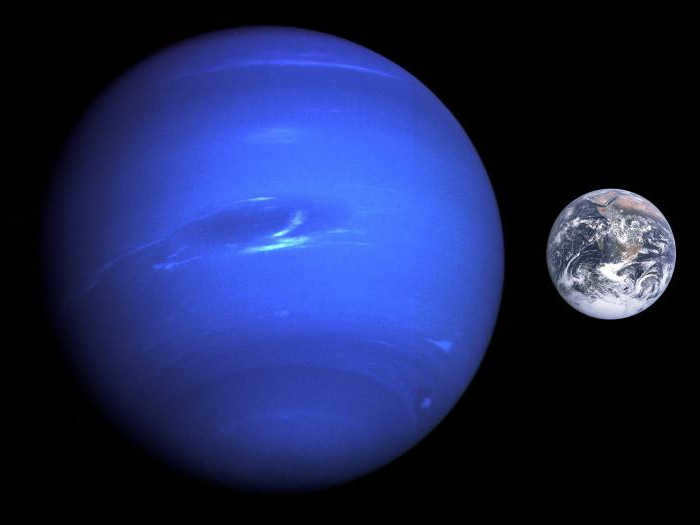
This celestial body is the farthest from the star in our solar system, so the majority of the knowledge we have about it is based on calculations and observations conducted from a distance.
A single revolution around the sun on Neptune lasts for nearly 165 Earth years. The atmosphere on this planet is extremely unstable, causing its equator to complete a full rotation in just 18 hours, while its poles do so in 12 hours. Additionally, the magnetic field on Neptune rotates every 16.1 hours.
The immense gravitational force of this giant planet has a significant impact on the objects present in the Kuiper belt. There is evidence suggesting that Neptune has disrupted several regions within this belt, leading to the formation of gaps in its structure. The temperature at the center of Neptune reaches a scorching 7,000 degrees Celsius, which is comparable to the temperatures found on other known planets or even the surface of the Sun.
Although the gas giants in our solar system share certain similarities, they are unique celestial bodies that deserve thorough investigation and exploration in order to expand our understanding of them.
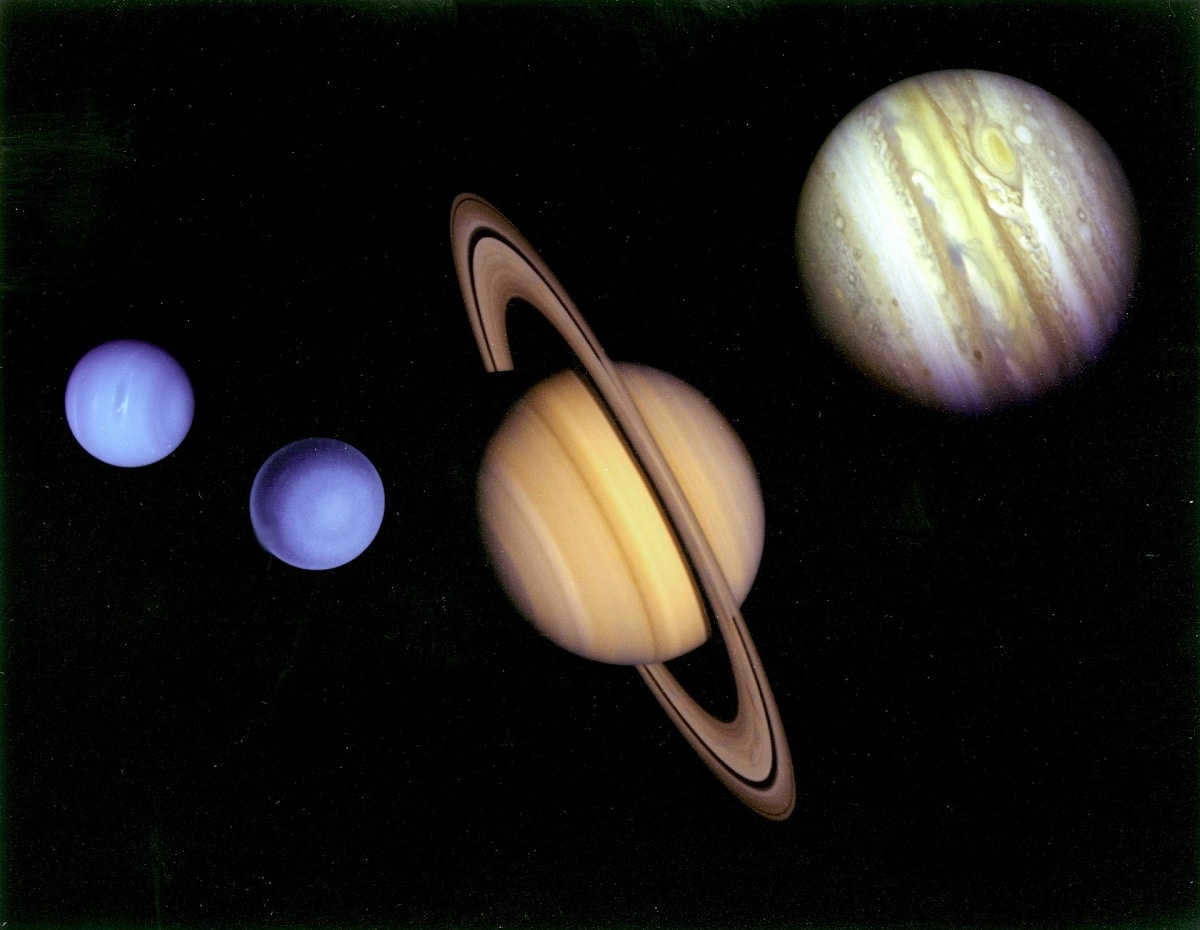
It is common knowledge that within the solar system, there exist a variety of planet types with differing characteristics and compositions. Among these are the gas giants, massive planets primarily composed of gases such as hydrogen and helium, with a relatively small solid core. Unlike other rocky planets, which consist entirely of rock with a gaseous atmosphere, gas giants are dominated by gases.
This article aims to provide an in-depth exploration of the characteristics, distinctions, and fascinating aspects of gas giants.
What are the characteristics of gaseous planets?
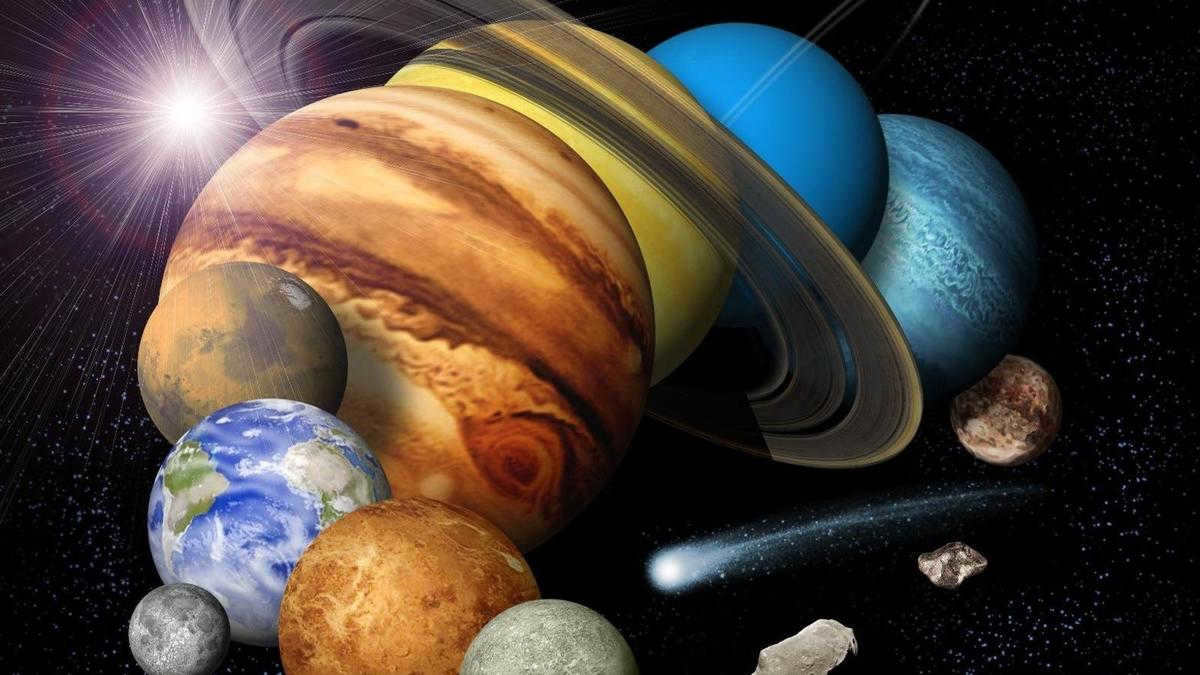
Upon first inspection and based on the given title, one might assume that we are discussing spherical objects or gaseous substances. However, we are actually referring to a celestial body with a rocky core and a gaseous exterior. These gases typically consist mostly of hydrogen and helium. Within our solar system, the gaseous planets include Jupiter, Saturn, Uranus, and Neptune. These four immense planets are also referred to as gas giants or outer planets, as they are located in the outer region of our solar system beyond the orbits of Mars and the asteroid belt.
Although Jupiter and Saturn are the largest among the gas planets, Uranus and Neptune possess slightly different compositions and possess unique characteristics. When discussing gaseous planets, it becomes evident that they are predominantly composed of hydrogen, thus reflecting the composition of the original solar nebula.
What are these called?
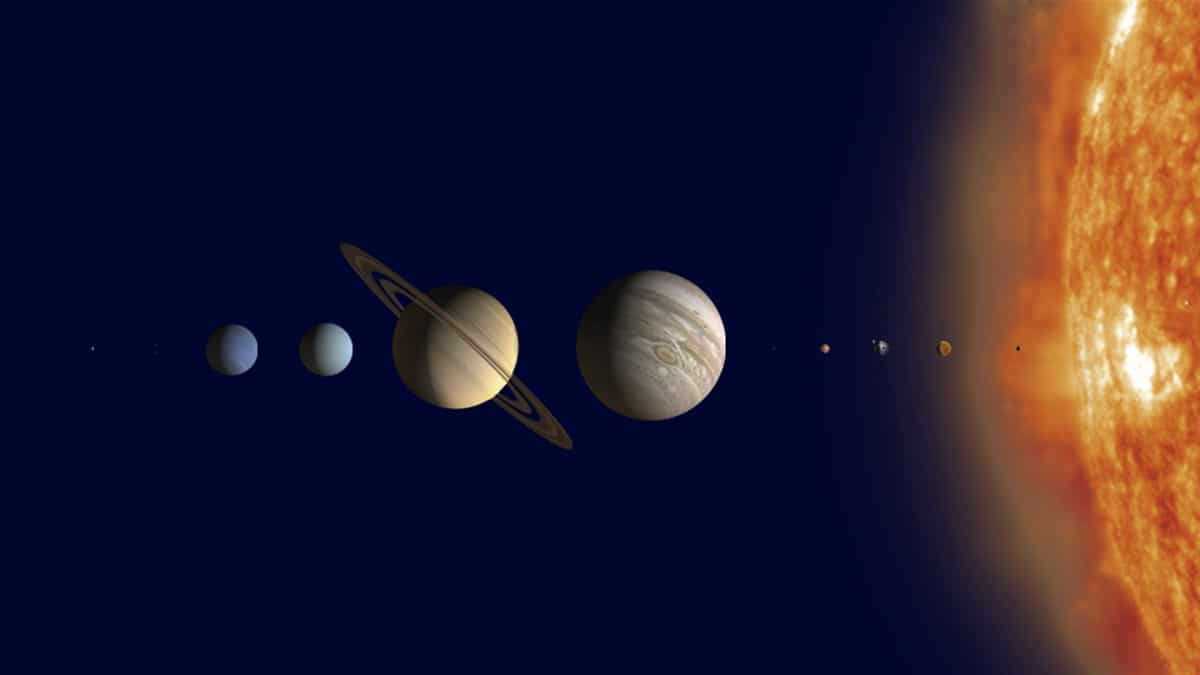
Let’s enumerate the main gaseous planets in our solar system:
- Jupiter: It is the largest planet in the entire solar system. It earns the title of a giant planet due to its enormous size. Its composition is primarily hydrogen and helium, with a dense core of rock and ice. Its size grants it a strong magnetic field and makes it visible to the naked eye. From Earth, it appears as a much brighter reddish star. One of Jupiter’s notable features is the red spot, which is a result of high atmospheric pressure and thick clouds.
- Uranus: The unique characteristic of Uranus is that it is tilted on its side, unlike any other planet. Additionally, it rotates in the opposite direction to all the other planets. Its atmosphere is primarily composed of hydrogen and helium, but it also contains methane. Uranus completes its orbit around the Sun in 84 Earth years and has a total of 5 major satellites.
- Neptune: Similar to Uranus, Neptune has a composition of atmosphere that includes methane. It currently has 13 confirmed satellites and was discovered by multiple individuals in 1846. Unlike Uranus, Neptune has a much slower orbit that is almost circular, taking approximately 164 Earth years to complete one revolution around the Sun. It has a rotation period of approximately 18 hours and shares a similar structure to Uranus.
When it comes to categorizing these gaseous planets, it should be noted that due to the variations in their structure and composition, they are also distinguished from one another. Jupiter and Saturn are classified as gas giants, whereas Uranus and Neptune are referred to as ice giants. Due to their position in the solar system and their distance from the Sun, their cores consist of a combination of rock and ice.
Distinctive Features of the Gas Giants
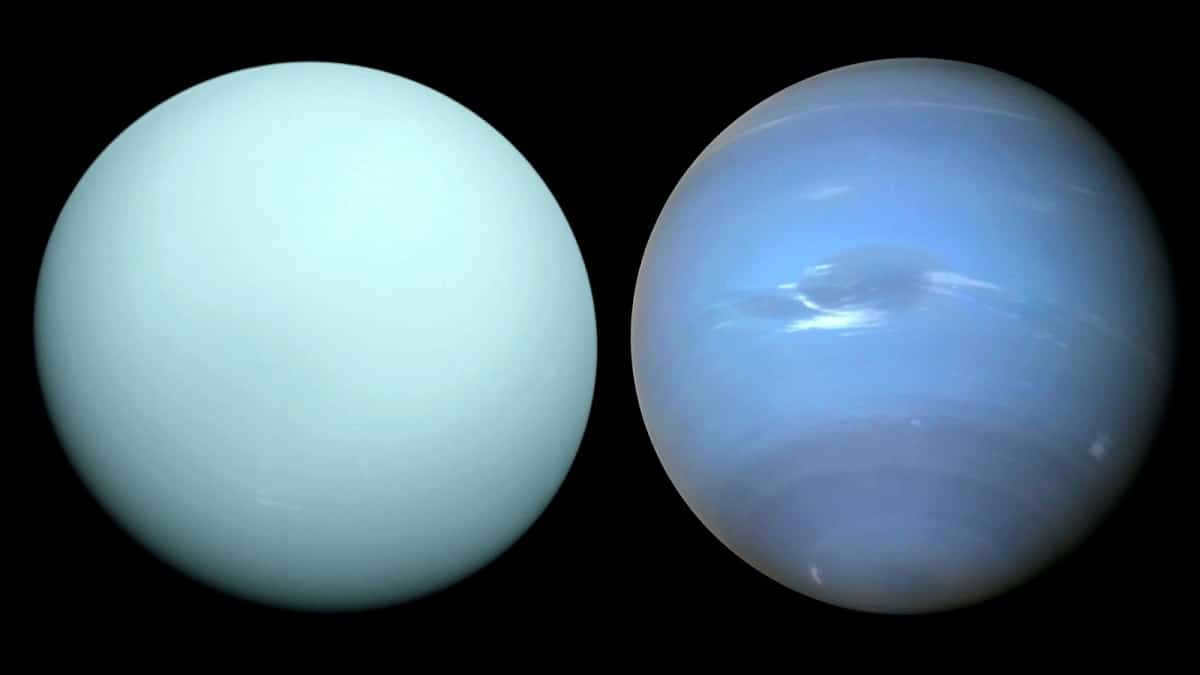
Now let’s take a look at the key characteristics that define these gas planets:
- They lack a clearly defined surface. As the core is the only solid component and everything else is gaseous, these planets do not have a well-defined surface.
- They consist of a massive amount of gas, predominantly hydrogen and helium.
- When scientists mention the diameters, surfaces, volumes, and densities of these planets, they are referring to the outer layer observed from the outside.
- Their atmospheres are highly dense, which is why the gases remain confined to these planets and do not disperse throughout the rest of the universe.
- The planets known as Jupiter planets are similar in size and characteristics to Jupiter.
- Their density is low and their core is rocky. It is important to note that due to their composition mostly of gases, their density is very low. However, their core is denser.
- When it comes to the amount of light received, they have relatively low temperatures. The coldest planet is Neptune.
- They have a fast rotation speed, averaging 10 hours. However, their orbital motion around the Sun is much slower.
- Their magnetic and gravitational fields are highly powerful. This is why they are able to retain large amounts of gases.
- All of them have very similar atmospheres and weather conditions.
Distinctive Features of Gas Planets
One of the key distinctions between gas planets and rocky planets lies in their composition. Gas planets, unlike their rocky counterparts, are primarily composed of hydrogen, helium, and methane. In other words, gas planets consist mostly of gases, whereas other planets are comprised of solid rocks.
Furthermore, gas planets differ from rocky planets in terms of their surfaces. Rocky planets possess well-defined surfaces, while gas planets have primary atmospheres that were captured directly from the original solar nebula. On the other hand, rocky planets have secondary atmospheres formed through internal geologic processes. As human technology advances, we are able to study these gas planets in greater detail.
By familiarizing yourself with these facts, you can gain a deeper understanding of the unique characteristics exhibited by gas planets.
The information provided in this article adheres to our editorial standards. If you notice any inaccuracies, please click here to report them.
Summary of the Article: Network Meteorology " astronomy " Gas Giants
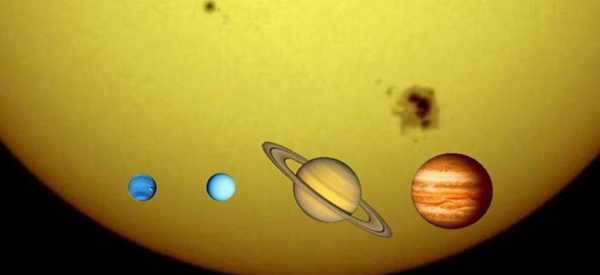
The solar system consists of four gas giants, which are truly remarkable celestial bodies composed mainly of different gases. It is widely believed among astronomers that these planets also contain a solid core within their gaseous composition.
Distinctive features
The gas giants in the solar system possess a range of unique characteristics:
- They have an orbit that is located at a greater distance from the Sun;
- They are of considerable size;
- These giants have a low density;
- They rotate at a rapid pace;
- These giants also have a number of satellites in close proximity to them.
Gas giants are primarily composed of hydrogen, with the presence of helium, methane, and various other elements.
Jupiter is the Solar System’s largest and most extensively researched celestial body. It possesses a formidable magnetic field that results in constant and powerful winds on the planet. Because of its rapid rotation, a day on Jupiter only lasts 10 hours.
Saturn
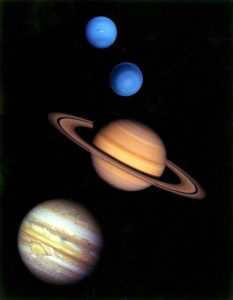
Arranged from highest to lowest: Neptune, Uranus, Saturn, and Jupiter (not drawn to scale).
Saturn, the second largest planet, also rotates on its own axis every 10 hours. The length of its year is 29 Earth years. It is renowned for its multitude of rings, composed of solid rock, as well as ice formations and dust particles. These objects vary in size from a few millimeters to hundreds of meters.
Unlike water, Saturn has a low density. Strong winds blow continuously across its surface.
Rephrased Text:
Uranus is composed of hydrogen, methane, and helium in its atmosphere. The surface of the planet contains various rock formations and a significant amount of ice.
The temperature at Uranus’ surface reaches as low as -224 degrees Celsius. Scientists believe that water might also be present on the planet.
One unique characteristic of Uranus is that its equator is positioned perpendicular to its orbit. A day on Uranus lasts slightly over 17 hours, while a complete orbit around the sun takes approximately 84 years.

